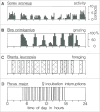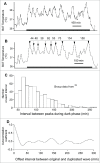Timing of activities of daily life is jaggy: How episodic ultradian changes in body and brain temperature are integrated into this process
- PMID: 28349079
- PMCID: PMC5079224
- DOI: 10.1080/23328940.2016.1177159
Timing of activities of daily life is jaggy: How episodic ultradian changes in body and brain temperature are integrated into this process
Abstract
Charles Darwin noted that natural selection applies even to the hourly organization of daily life. Indeed, in many species, the day is segmented into active periods when the animal searches for food, and inactive periods when the animal digests and rests. This episodic temporal patterning is conventionally referred to as ultradian (<24 hours) rhythmicity. The average time between ultradian events is approximately 1-2 hours, but the interval is highly variable. The ultradian pattern is stochastic, jaggy rather than smooth, so that although the next event is likely to occur within 1-2 hours, it is not possible to predict the precise timing. When models of circadian timing are applied to the ultradian temporal pattern, the underlying assumption of true periodicity (stationarity) has distorted the analyses, so that the ultradian pattern is frequently averaged away and ignored. Each active ultradian episode commences with an increase in hippocampal theta rhythm, indicating the switch of attention to the external environment. During each active episode, behavioral and physiological processes, including changes in body and brain temperature, occur in an integrated temporal order, confirming organization by programs endogenous to the central nervous system. We describe methods for analyzing episodic ultradian events, including the use of wavelet mathematics to determine their timing and amplitude, and the use of fractal-based procedures to determine their complexity.
Keywords: basic rest-activity cycle; brown adipose tissue; chronobiology; circadian rhythms; eating; fractals; homeostasis; natural selection; thermogenesis; ultradian rhythms; wavelets.
Figures








Comment in
-
Brain control of body temperature: Central command vs feedback.Temperature (Austin). 2016 Jul 19;3(3):362-363. doi: 10.1080/23328940.2016.1211503. eCollection 2016. Temperature (Austin). 2016. PMID: 28352141 Free PMC article. No abstract available.
-
Fractal analysis of thermoregulatory complexity.Temperature (Austin). 2016 Jul 19;3(3):364-365. doi: 10.1080/23328940.2016.1213349. eCollection 2016. Temperature (Austin). 2016. PMID: 28352142 Free PMC article. No abstract available.
Similar articles
-
Thermoregulation and the ultradian basic rest-activity cycle.Handb Clin Neurol. 2018;156:367-375. doi: 10.1016/B978-0-444-63912-7.00022-9. Handb Clin Neurol. 2018. PMID: 30454601 Review.
-
Brown adipose tissue thermogenesis heats brain and body as part of the brain-coordinated ultradian basic rest-activity cycle.Neuroscience. 2009 Dec 1;164(2):849-61. doi: 10.1016/j.neuroscience.2009.08.013. Epub 2009 Aug 11. Neuroscience. 2009. PMID: 19679172 Free PMC article.
-
Brown adipose tissue thermogenesis, the basic rest-activity cycle, meal initiation, and bodily homeostasis in rats.Physiol Behav. 2013 Sep 10;121:61-9. doi: 10.1016/j.physbeh.2013.03.028. Epub 2013 Apr 3. Physiol Behav. 2013. PMID: 23562865 Review.
-
The integrated ultradian organization of behavior and physiology in mice and the contribution of orexin to the ultradian patterning.Neuroscience. 2016 Oct 15;334:119-133. doi: 10.1016/j.neuroscience.2016.07.041. Epub 2016 Aug 1. Neuroscience. 2016. PMID: 27491480
-
Modified Wavelet Analyses Permit Quantification of Dynamic Interactions Between Ultradian and Circadian Rhythms.J Biol Rhythms. 2022 Dec;37(6):631-654. doi: 10.1177/07487304221128652. Epub 2022 Nov 15. J Biol Rhythms. 2022. PMID: 36380564 Free PMC article.
Cited by
-
Kisspeptin impacts on circadian and ultradian rhythms of core body temperature: Evidence in kisspeptin receptor knockout and kisspeptin knockdown mice.Mol Cell Endocrinol. 2022 Feb 15;542:111530. doi: 10.1016/j.mce.2021.111530. Epub 2021 Dec 8. Mol Cell Endocrinol. 2022. PMID: 34896241 Free PMC article.
-
Ultradian Near 2-4-h Rhythms of Body Temperature in Laboratory Rodents Depend on External Environmental Heliogeophysical Factor Reflected by Neutron Monitor Count Rate.Bull Exp Biol Med. 2022 May;173(1):92-97. doi: 10.1007/s10517-022-05500-8. Epub 2022 May 27. Bull Exp Biol Med. 2022. PMID: 35618968
-
Role of the Preoptic Area in Sleep and Thermoregulation.Front Neurosci. 2021 Jul 1;15:664781. doi: 10.3389/fnins.2021.664781. eCollection 2021. Front Neurosci. 2021. PMID: 34276287 Free PMC article. Review.
-
Effects of autonomic denervations on the rhythms in axial length and choroidal thickness in chicks.J Comp Physiol A Neuroethol Sens Neural Behav Physiol. 2019 Feb;205(1):139-149. doi: 10.1007/s00359-018-01310-4. Epub 2019 Jan 2. J Comp Physiol A Neuroethol Sens Neural Behav Physiol. 2019. PMID: 30604271 Free PMC article.
-
Phase Analysis of Ultradian Rhythms of Body Temperature in Laboratory Mice Maintained under Constant Illumination at Different Longitudinal Locations.Bull Exp Biol Med. 2021 Nov;172(1):72-76. doi: 10.1007/s10517-021-05334-w. Epub 2021 Nov 18. Bull Exp Biol Med. 2021. PMID: 34791558
References
-
- Pittendrigh CS. Temporal organization: Reflections of a Darwinian clock-watcher. Ann Rev Physiol 1993; 55:17-54; PMID:8466172; http://dx.doi.org/10.1146/annurev.ph.55.030193.000313 - DOI - PubMed
-
- Darwin C. On the Origin of Species by Means of Natural Selection. The Floating Press, ISBN: 9781775415374 (ebook) 2009 p151. Originally published in 1859.
-
- Szymanski JS. Aktivität und ruhe bei tieren und menschen. Zeitschrift Fjur Allgerneine Physiol 1920; 18:105-62.
-
- Richter CP. A behavioristic study of the activity of the rat. Comp Psychol Monogra 1922; 1:1-55.
-
- Kleitman N. Basic rest-activity cycle–22 years later. Sleep 1982; 5:311-7; PMID:6819628 - PubMed
Publication types
LinkOut - more resources
Full Text Sources
Other Literature Sources
